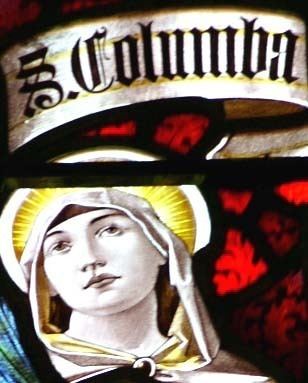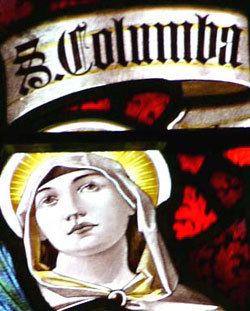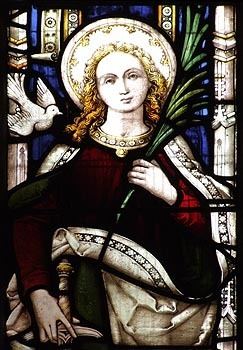Name Columba Virgin Role Saint | Died Ruthvoes, United Kingdom Major shrine St Columb Major | |
 | ||
Venerated in Roman Catholicism; Anglican Communion Feast 11 November/15 November Attributes female carrying a palm branch and a sword, a dove hovering above | ||
Saint Columba the Virgin is a female saint with dedications in Cornwall and other Celtic regions. She probably lived in the 6th century.
Contents

The Legend

The legend of Saint Columba, the Virgin, is recorded in a manuscript in the University Library of Cambridge, written by Nicholas Roscarrock in the reign of Elizabeth I and he says he gathered it from local information.
This states that Columba was the daughter of King Lodan and Queen Manigild, both pagans. She became a Christian when the Holy Ghost appeared to her in the form of a dove. The Latin word for dove is 'columba'. When she refused to marry a pagan prince, her parents had her imprisoned. She escaped with the help of an angel and took ship for Cornwall but was followed by the prince. She landed at Trevelgue Head and was pursued through the forest which is now Porth Beach, and fled up the valley, past Rialton and Treloy until she was captured at Ruthvoes, two miles south of St Columb Major. There the prince cut off her head, and where the blood fell a spring gushed forth and the water following the course of her flight made the still unnamed river which empties itself at St Columb Porth. Orme points out that Ruthvoes' meaning derives from "red bank", whose red soil may have suggested the location and manner of the martyrdom.
Analysis
This legend bears many parallels with the legend of Saint Columba of Sens and the Greek legend of Arethusa a nereid (a water nymph). Arethusa, like Columba was a maiden, she preferred to remain chaste. During the course of her adventures, she decided to take a dip in the welcoming water. But as soon as she entered the river, she realized that she was not alone. For the god of this particular river (who was named Alpheus) was roused by the sight of Arethusa, and immediately fell in love with the nymph. Arethusa fled the advances of Alpheus. However, Alpheus was not so easily deterred - the god of the river simply assumed the form of a hunter and pursued his chosen prey. Some versions of the story say that Arethusa was chased over the sea, all the way to Sicily. Finally, she found refuge on the Island of Ortygia (which is near Syracuse), where she called upon the goddess Artemis to rescue her. Artemis responded by transforming the nymph into a spring or fountain. And this is how the nymph Arethusa became identified with a now legendary spring.
Columba is a popular Irish name and Sabine Baring-Gould thought she was really a man. David Nash Ford suggests her parents, Lodan and Manigild, are corrupt forms of Lot and Morgause of Arthurian legend.
Veneration
Her cult was centered on the nearby churches St Columb Major, and St Columb Minor, where her feast day is on 11 and 15 November respectively. (The saint honored at Plougoulm, Brittany is male.)
